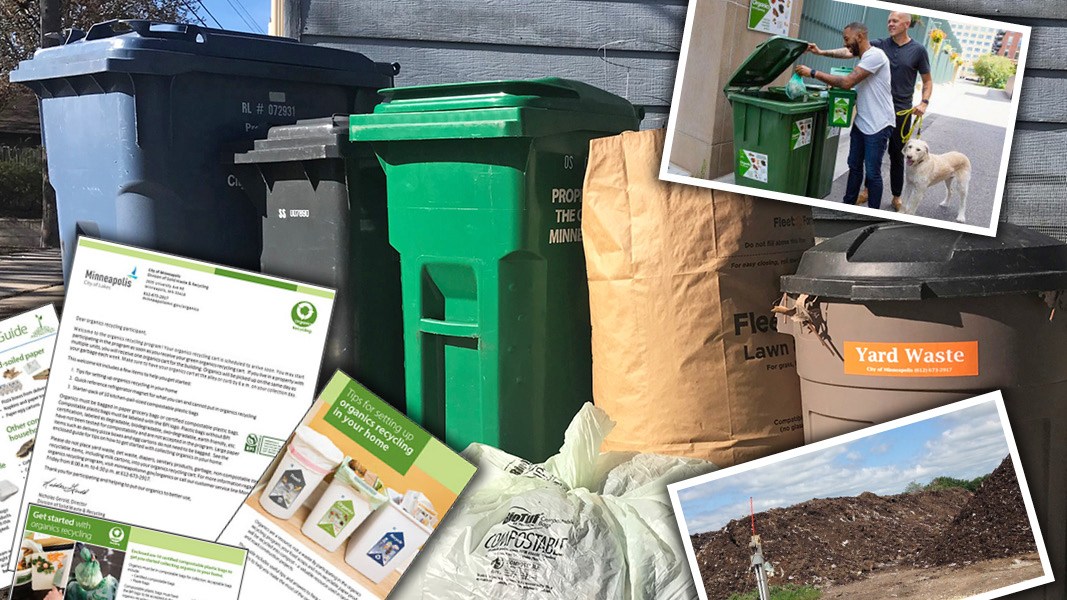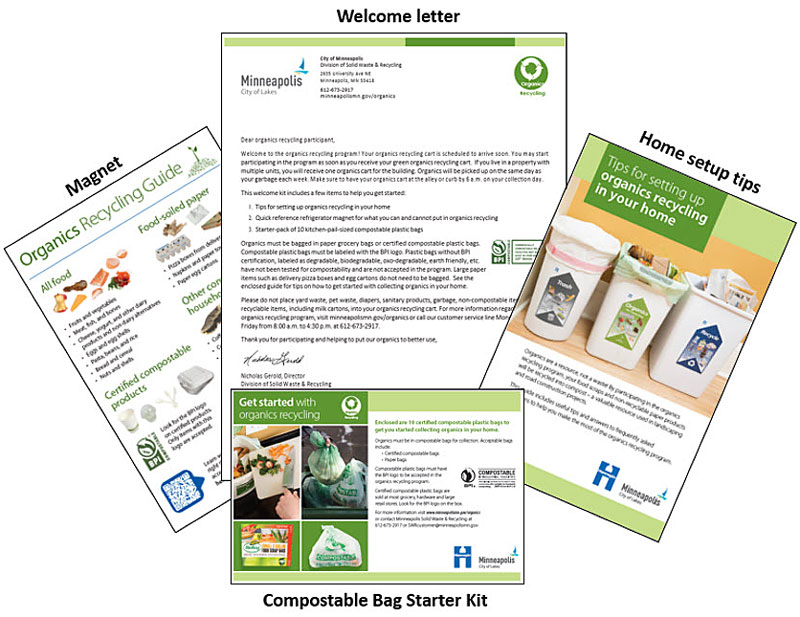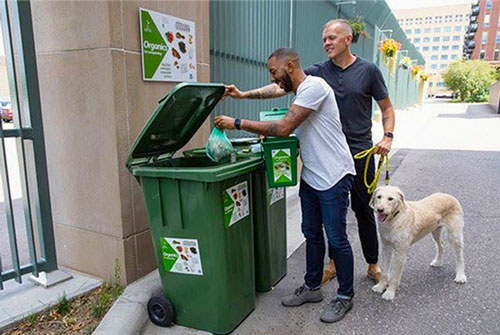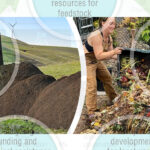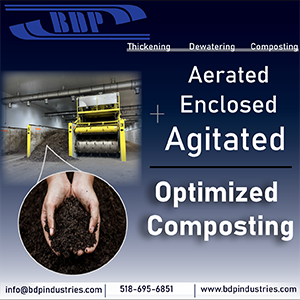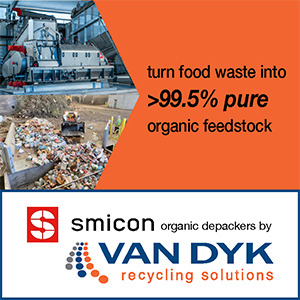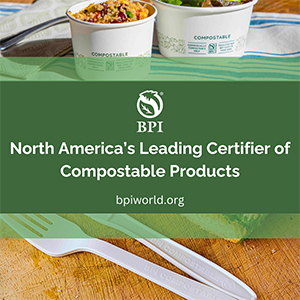Top: Residential curbside set-out (top). Drop-off station (top right), SET, Inc. composting facility (lower right), outreach and education materials (lower left). Photos/graphics courtesy City of Minneapolis Department of Solid Waste & Recycling, SET, Inc. and Hennepin County, MN
Nora Goldstein
Curbside collection of food scraps in Minneapolis, Minnesota, began as a pilot in one neighborhood in 2008 and rolled out citywide in 2015-2016. When the curbside pilot was launched, the city and a neighborhood group in the pilot area recruited block leaders who went door-to-door with educational materials and to answer questions, resulting in more than 50% of households in the targeted pilot neighborhoods signing up to participate. “There was demand from households not in the pilot neighborhoods to have access to food scraps collection, which led the City to open its first drop-off location in 2014,” recalls Kellie Kish, the City of Minneapolis’ Recycling Coordinator. “Additional drop-off locations were opened periodically over the years, focusing primarily on neighborhoods not eligible for curbside collection, e.g., where there is density of multi-family households.”
In addition to providing food scraps collection access, the drop-off sites helped to create source separation behavior and develop “community leaders/super recyclers” who could be activated for the City’s roll out of curbside collection (similar to use of block leaders in the first pilot neighborhoods). When each drop-off site opened, the hours to access them were limited (three hours on one weekday evening and on Saturday morning). Volunteers were recruited to staff the drop-off sites when open to collect information from households dropping off food scraps. Details requested included a household’s willingness to use a drop-off site or pay more (and if so, how much) for curbside pick-up. Volunteers recorded the number of bags of food scraps dropped off and the household size. This information informed messaging in educational materials used to engage households to participate when full-scale curbside service began 10 years ago.
Curbside Organics Collection
Residents in a 4-unit building or smaller receive City-provided curbside solid waste service that includes food scraps collection. Food scraps, yard trimmings and trash are collected weekly in the curbside program; recyclables are collected every other week. The monthly base rate of $32.11 (2025) covers collection, processing and all costs associated with recycling, large item collection, source separated organics, yard trimmings, trash collection and several other services. The trash cart fee is additional; a small 32-gallon cart is $2/month; a large 96-gallon cart is $5/month. This pay-as-you-throw structure incentivizes households to increase organics and recycling diversion.
Even though households are paying for food scraps collection, they need to opt in by completing a form on the City’s website. Buildings with one to two units receive a 32-gallon cart and start-up kit that includes a home setup guide, refrigerator magnet, and a starter set of compostable bags. Buildings with three to four units receive a 64-gallon cart and the same start-up items The curbside and drop-off organics program accepts all food scraps, food-soiled paper (including pizza boxes), and BPI certified compostable products (plates, cups, bowls, takeout containers and utensils), houseplant trimmings and flowers, paper towels and tissues. The organics must be bagged for collection in brown paper bags or certified compostable bioplastic bags that carry the BPI logo. Collected food scraps and yard trimmings are taken to Specialized Environmental Technologies (a WM company), a commercial composting facility in Rosemount (MN).
The number of dwelling units currently eligible for organics collection is 108,018; 56,639 households, or 52.44% of all dwelling units have opted in. About 70% of program participants are single-family homes. The City’s staff and rear loader fleet services about half of the curbside households in Minneapolis. The other 50% is serviced by a consortium of private haulers comprised of “mom and pop” companies that have been providing collection in those neighborhoods for many years. The City wanted to support these haulers thus the consortium has had the collection contract since the food scraps program began. All collection crews check cart contents before dumping or leave the educational tag if contamination is found. (Part II of this article includes cart tagging data.)
Multi-family buildings (5+ housing units) may be eligible to opt into the City’s collection program for organics-only service, or they can contract with a private hauler for food scraps collection. If accepted by the City’s program, 64-gallon carts are provided. Depending on the building’s interest, they can also be equipped with a locking mechanism, similar to a drop-off site, and building residents sign up and receive a code to access the cart. There has been a steady increase in interest in organics- only service by multi-family buildings.
Food Scraps Drop-Off
Residents without city collection services (5+ unit buildings) are not assessed a monthly service fee and it is free to use the drop-off sites, which are open 24/7. However, sign-up is required to access the drop-off bins as they are locked, excepting during the winter months, and a code is needed to open them. “The locks freeze in the winter, preventing folks from being able to open them,” explains Kish. “Also there’s less people out and about in the wintertime which results in less contamination from people passing by when the carts are unlocked.” The City of Minneapolis manages all but one of the 20 drop-off sites in the city. The exception is a site at a church near the University of Minnesota, serviced by a private hauler. All drop-off sites managed by the City use 64-gallon carts.
On average, three 64-gallon carts serviced once a week are sufficient for every 150 residents signed up for a location. Factors that go into determining a drop-off site location include proximity to another drop-off site, density of multi-family buildings, and how many rental or condo units are in those buildings (based on rental license data). “In some cases, if a neighborhood only has 12 or so buildings, we may decide to encourage them to start an organics program at their building rather than open a new drop-off site,” explains Kish. “Where there is more density, drop-off locations may be sited within six blocks of each other. We have learned that in a high-density neighborhood, having to walk more than six blocks to reach a drop-off site is too far a distance.”
Among the lessons learned over the 11 years in terms of managing drop-off sites are:
- Requiring sign-ups for a designated site helps with contamination control. When contaminated carts are found at a specific location, all households signed up for that drop-off site receive an email notification about the contamination and a reminder on what is accepted.
- Encourage community groups to partner with businesses to host drop-off sites. One of the City’s busiest sites is at a food co-op (12 carts).
- Once a week pickup and fewer carts at each drop-off site have been found to be adequate. One location originally had 16 carts being serviced three times/week (prior to the citywide curb/alley roll-out). Today, it has an average of eight carts being serviced weekly.
- Monitor carts periodically and clean them one to two times a year. Also budget for loss of a few locks each year.
In 2024, a total of 5,194 tons of food scraps were captured from the curbside and drop-off food scraps collection programs. (In addition, 17,788 tons of yard trimmings were collected.) To measure the quantity of food scraps from drop-off locations, the city uses the number of carts emptied and an estimate of about 50 pounds of food scraps in each cart (an average accounting for the variation of materials in the cart, e.g., pizza boxes vs. watermelons). In 2024, a total of 3,540 carts used by 5,549 subscribers were emptied, capturing an estimated 90 tons of food scraps.
Outreach, Education and Community Engagement
When first launching the curb/alley collection program, outreach and education were done through paid media on television, radio and bus ads, and social media. Printed materials include mailers, utility bill inserts and distribution of flyers door-to-door. In-person trainings and workshops are held. Sending an annual mailer (in Minneapolis’ case it is a booklet) is required by state statute. “Anytime we send out a big mailing, we always see an increase in sign-ups ,” notes Kish, adding that usage of the bin tends to increase in the spring. “In the beginning (2015-2016), 50% of residents reported hearing about the program in some oral fashion — at an event, from their neighbor, or through door-knocking efforts.”
Community groups are eligible for Hennepin County’s Green Partner grants (up to $12,000 for a one-year grant) for outreach initiatives that help residents take action to prevent and reduce waste, separate organic waste and recycle, reduce household hazardous waste, combat climate change, and more. One community group in Minneapolis uses its Green Partner grant to increase household participation in the City’s food scraps collection program. In the past, a neighborhood association submitted information requests to the Solid Waste & Recycling Division to get the addresses of households in the neighborhoods the group services who are enrolled in the curbside food scraps program. A map of those neighborhoods was created and push pins were used to mark participating households. The group took the map to community events where it used the map to engage households who are not participating.
Reluctance to participate cited by households includes concerns about odors and lack of space to accommodate a third cart. The most significant challenge the City faces in terms of enrollment is with rental housing, which comprises 50% of housing in Minneapolis. Landlords are not required to report when units turn over, and new tenants may not learn about their access to food scraps collection until the City sends its annual mailer. “In one neighborhood where we were doing door knocking, we learned that 50% of the housing units are rental, and that 50% of the rentals turn over every six months,” says Kish. “If we could find a mechanism to know when new renters move in, we could get them program information more quickly.”
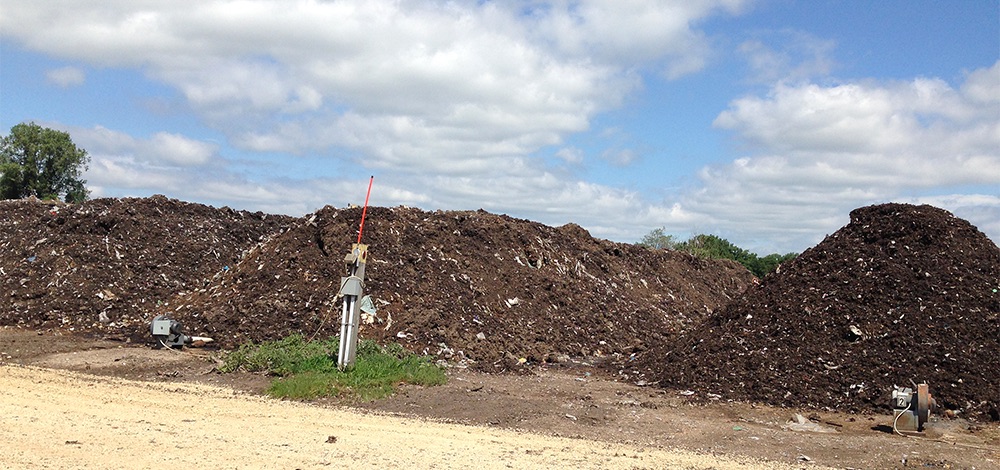
Collected food scraps and yard trimmings are composted at Specialized Environmental Technologies (a WM company), in Rosemount (MN). Photo courtesy of SET, Inc.
Program Costs
The City of Minneapolis has an enterprise fund to provide solid waste services. The rates are based on the City’s costs to provide collection of trash, recycling, organics, and bulky items, and a residential garbage/building material drop-off voucher program — as well as the processing fees for all waste streams excepting trash. In a 2024 form submitted to the State of Minnesota’s SCORE program (Governor’s Select Committee on Recycling and Environment), the City reported the cost of organics collection is $4.92 million/year, not including overhead and administrative and educational costs. The SCORE program, administered through the counties, provides funding (derived from a state solid waste management tax) that counties pass through to its jurisdictions to cover program costs. The City of Minneapolis allocates a portion of its SCORE funds to cover the costs of the organics drop-off sites.
The Solid Waste & Recycling Division’s goal is to have 100% of households in Minneapolis signed up for food scraps collection, both curbside and drop-off. Its ultimate goal is to reduce the amount of wasted food in the trash by 95%.
An increased focus on utilizing neighborhood and community groups to promote participation in the City’s food scraps collection programs is a priority going forward, especially with Hennepin County’s Green Partners Grant program. “Minneapolis has well organized neighborhood groups for every part of the city,” notes Kish. “We also want to work more closely with cultural groups in Minneapolis to facilitate programming for non-English speaking residents.”
Part II of the article focuses on the collected residential organics, including the results of a 2024 organics sort conducted by the City of Minneapolis and staffed by volunteers.


